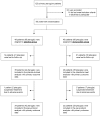Oral doxycycline reduces pterygium lesions; results from a double blind, randomized, placebo controlled clinical trial
- PMID: 23285154
- PMCID: PMC3526544
- DOI: 10.1371/journal.pone.0052696
Oral doxycycline reduces pterygium lesions; results from a double blind, randomized, placebo controlled clinical trial
Abstract
Purpose: To determine whether oral doxycycline treatment reduces pterygium lesions.
Design: Double blind, randomized, placebo controlled clinical trial.
Participants: 98 adult patients with primary pterygium.
Methods: Patients were randomly assigned to receive 100 mg oral doxycycline twice a day (49 subjects), or placebo (49 subjects), for 30 days. Photographs of the lesion were taken at the time of recruitment and at the end of the treatment. Follow-up sessions were performed 6 and 12 months post-treatment. Statistical analyses for both continuous and categorical variables were applied. p values of less than 0.05 were considered to indicate statistical significance.
Main outcome measures: The primary endpoint was the change in lesion size after 30 days of treatment.
Results: The primary endpoint was not met for the whole population but subgroup analysis showed that doxycycline was effective in patients of Caucasian origin while other ethnicities, mostly Hispanic, did not respond to the treatment. Moreover, there was a correlation between age and better response (p = 0.003). Adverse events were uncommon, mild, and in agreement with previous reports on short doxycycline treatments.
Conclusions: Oral doxycycline was superior to placebo for the treatment of primary pterygia in older Caucasian patients. These findings support the use of doxycycline for pterygium treatment in particular populations.
Trial registration: European Union Clinical Trials Register EudraCT 2008-007178-39.
Conflict of interest statement
Figures




Similar articles
-
Doxycycline's effect on ocular angiogenesis: an in vivo analysis.Ophthalmology. 2010 Sep;117(9):1782-91. doi: 10.1016/j.ophtha.2010.01.037. Epub 2010 Jun 3. Ophthalmology. 2010. PMID: 20605212 Free PMC article.
-
Doxycycline for outpatient-treated acute exacerbations of COPD: a randomised double-blind placebo-controlled trial.Lancet Respir Med. 2017 Jun;5(6):492-499. doi: 10.1016/S2213-2600(17)30165-0. Epub 2017 May 5. Lancet Respir Med. 2017. PMID: 28483402 Clinical Trial.
-
Efficacy, Safety, and Tolerability of Oral DFD-29, a Low-Dose Formulation of Minocycline, in Rosacea: Two Phase 3 Randomized Clinical Trials.JAMA Dermatol. 2025 May 1;161(5):499-507. doi: 10.1001/jamadermatol.2024.6542. JAMA Dermatol. 2025. PMID: 40042869 Clinical Trial.
-
Oral antibiotics for chronic blepharitis.Cochrane Database Syst Rev. 2021 Jun 9;6(6):CD013697. doi: 10.1002/14651858.CD013697.pub2. Cochrane Database Syst Rev. 2021. PMID: 34107053 Free PMC article.
-
Antibiotics for treating urogenital Chlamydia trachomatis infection in men and non-pregnant women.Cochrane Database Syst Rev. 2019 Jan 25;1(1):CD010871. doi: 10.1002/14651858.CD010871.pub2. Cochrane Database Syst Rev. 2019. PMID: 30682211 Free PMC article.
Cited by
-
Predictive Biomarkers of Age-Related Macular Degeneration Response to Anti-VEGF Treatment.J Pers Med. 2021 Dec 8;11(12):1329. doi: 10.3390/jpm11121329. J Pers Med. 2021. PMID: 34945801 Free PMC article.
-
Tetracyclines and photosensitive skin reactions: A narrative review.Dermatol Ther. 2021 Jul;34(4):e14978. doi: 10.1111/dth.14978. Epub 2021 May 24. Dermatol Ther. 2021. PMID: 33991382 Free PMC article. Review.
-
A Phase IIa Multicenter, Randomized, Vehicle-Controlled, Dose Escalating Study to Evaluate the Safety, Efficacy, and Pharmacokinetics of CBT-001 Ophthalmic Solution in Patients With Primary or Recurrent Pterygium.Ophthalmol Sci. 2024 Mar 4;4(4):100502. doi: 10.1016/j.xops.2024.100502. eCollection 2024 Jul-Aug. Ophthalmol Sci. 2024. PMID: 38883924 Free PMC article.
References
-
- Dushku N, John MK, Schultz GS, Reid TW (2001) Pterygia pathogenesis: corneal invasion by matrix metalloproteinase expressing altered limbal epithelial basal cells. Arch Ophthalmol 119: 695–706. els00070 [pii]. - PubMed
-
- Di Girolamo N, Chui J, Coroneo MT, Wakefield D (2004) Pathogenesis of pterygia: role of cytokines, growth factors, and matrix metalloproteinases. Prog Retin Eye Res 23: 195–228. 10.1016/j.preteyeres.2004.02.002 [doi]; S1350946204000126 [pii]. - PubMed
-
- Chui J, Di Girolamo N, Wakefield D, Coroneo MT (2008) The pathogenesis of pterygium: current concepts and their therapeutic implications. Ocul Surf 6: 24–43. - PubMed
-
- Dushku N, Reid TW (1997) P53 expression in altered limbal basal cells of pingueculae, pterygia, and limbal tumors. Curr Eye Res 16: 1179–1192. - PubMed
-
- Weinstein O, Rosenthal G, Zirkin H, Monos T, Lifshitz T, et al... (2002) Overexpression of p53 tumor suppressor gene in pterygia. Eye (Lond) 16: 619–621. 10.1038/sj.eye.6700150 [doi]. - PubMed
Publication types
MeSH terms
Substances
LinkOut - more resources
Full Text Sources
Other Literature Sources
Medical
Miscellaneous

